Haunted house stories usually share a few common elements: an oppressive atmosphere and feeling of being trapped; a grand but dilapidated house that’s basically a character in its own right; and, of course, malevolent ghosts that make things go bump in the night. But some authors take these conventions and give them a twist, treading a rather more unconventional—and sometimes downright weird—path.
The following five novels don’t depict your typical haunting. But rest assured (unlike the poor characters in these books), I won’t spoil the surprise of exactly what makes these stories strange and unusual…
The Elementals (1981) by Michael McDowell
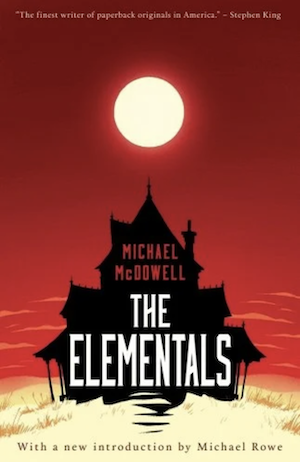
The words “haunted house” tend to conjure up an image of a mist-shrouded old manor on a dark October night. Michael McDowell’s Southern Gothic tale The Elementals certainly features the expected edifice—in this case, a rundown Victorian house—but rather than mist, it’s being swallowed by sand, and instead of being set during the autumn, the story takes place during the sweltering heat of an Alabama summer.
Each summer the wealthy McCray and Savage families withdraw from their busy lives to relax in their beach houses, which stand on a spit of sand on Alabama’s Gulf Coast. Along with the two houses that the families inhabit, there is also a vacant third house on the beach that is slowly being subsumed by a sand dune. The McCrays and Savages know that something is wrong with this slowly deteriorating house but they choose to ignore it—but that all changes when teenager India McCray visits the island for the first time and starts to investigate the strange happenings within its walls.
McDowell’s evocative descriptions of the heat and the beach make this the perfect haunted house story to pick up during the warmer months of the year, and the spooky atmosphere he creates proves to be just as oppressive as the unrelenting summer heat.
A House With Good Bones (2023) by T. Kingfisher
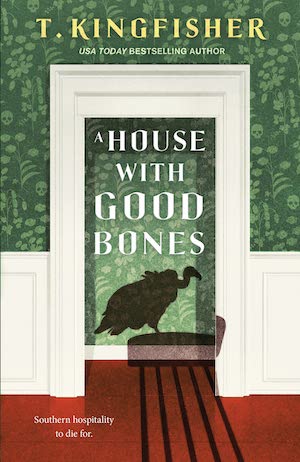
T. Kingfisher isn’t afraid to inject a little humor and weirdness into her horror novels, and A House with Good Bones delivers on both fronts. Main character Sam is an archaeoentomologist, which involves studying dead insects found at archaeological digs. The dig site she’s been working at is put on indefinite pause but she’s already sublet her room, and so she decides to stay with her mom until she can go back to sifting through dirt looking for bug husks.
When Sam arrives everything seems a little off. There’s a vulture watching the house, her mom seems jumpy and has stripped the decor of personality, and the beautiful rose garden planted by her Gran Mae (the previous owner of the house) is suspiciously insect-free. As Sam investigates the bizarre changes in her mom and the house, she’s forced to confront the insidious roots put down by her long-deceased grandmother. It’s a slow burn, but the eventual climax of the novel is delightfully unhinged.
The Handyman Method (2023) by Nick Cutter and Andrew F. Sullivan
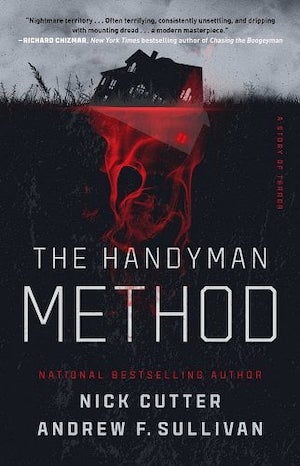
The Handyman Method sees Trent, Rita, and their son Milo move into a brand-new home in an as-of-yet unfinished housing development. There are a few things that already need to be fixed, but instead of getting a professional in, Trent decides he can tackle the problems himself with the help of a series of how-to videos by a YouTuber called Handyman Hank. Under the influence of this malevolent DIYer, Trent undergoes some Jack Torrance-esque personality changes, but the novel doesn’t follow in the footsteps of Stephen King’s The Shining (1977) for long…
Nick Cutter and Andrew F. Sullivan—whose writing styles blend seamlessly together—use this supernatural online haunting to dive into the very real-world horrors of toxic masculinity. Trent’s descent into patriarchal madness is painful to witness, but it also provides occasional moments of hilarious satire. The novel manages to be fun, thrilling, twisted, and harrowing all at once.
Along with its cutting social commentary, The Handyman Method also offers up some truly stomach-churning body horror (which sometimes involves animals), and the brutal and bloody imagery will linger in your mind long after you’ve turned the last page.
Mexican Gothic (2020) by Silvia Moreno-Garcia
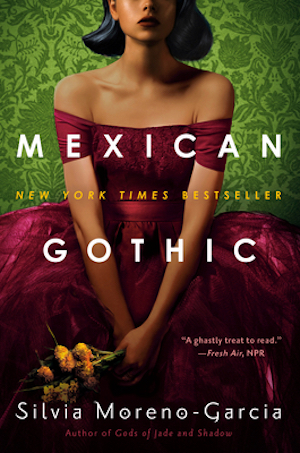
Mexican Gothic starts out feeling like a classic haunted house story. Noemí receives a worrying letter from her cousin, who has recently married and moved into a grand manor house that looms menacingly over a struggling Mexican mining town. Noemí sets off to make sure that her cousin is okay and finds that High Place is everything you’d expect from an old mansion with a ghost infestation—the once opulent house now feels like as if it’s rotting around its inhabitants, and an eerie atmosphere has settled over the building and its grounds.
Noemí isn’t made to feel welcome by the Doyle family, but she refuses to leave until she can figure out what’s going on. Through that process, the novel delves into the horrific legacy created by colonial exploitation and deep-rooted misogyny and racism. Noemí might not be easily spooked by the apparent ghosts or the sinister family, but she may be dealing with an even deeper evil.
No One Gets Out Alive (2014) by Adam Nevill
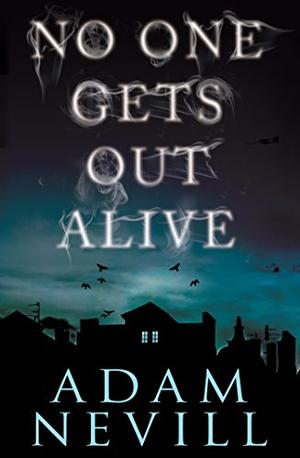
You may have seen the 2021 film adaptation of No One Gets Out Alive, but regardless of whether or not you liked it, the book is worth a read because it goes in a completely different—but equally unconventional—direction.
In the novel we follow Stephanie, who is down on her luck and in need of a cheap place to stay. She comes across 82 Edgehill Road—a large, decrepit house with rooms to rent—and while she gets bad vibes from Knacker McGuire, the creepy landlord, the price is undeniably right at just £40 (around $50) per week. On her first night there she experiences a few possibly paranormal incidents, but she doesn’t have the money to do the smart thing and leave.
Trapped by circumstance, the frights provided by whatever is haunting the house aren’t even the worst of Stephanie’s problems. It’s Knacker and his equally disgusting cousin that she really has to watch out for…at least to begin with. (Content warning for sexual violence.)
***
Have I missed your favorite stories that offer a twist on the classic haunted house narrative? Leave your own recommendations in the comments below!
Lorna Wallace has a PhD in English Literature and is a lover of all things science fiction and horror. She lives in Scotland with her rescue greyhound, Misty.










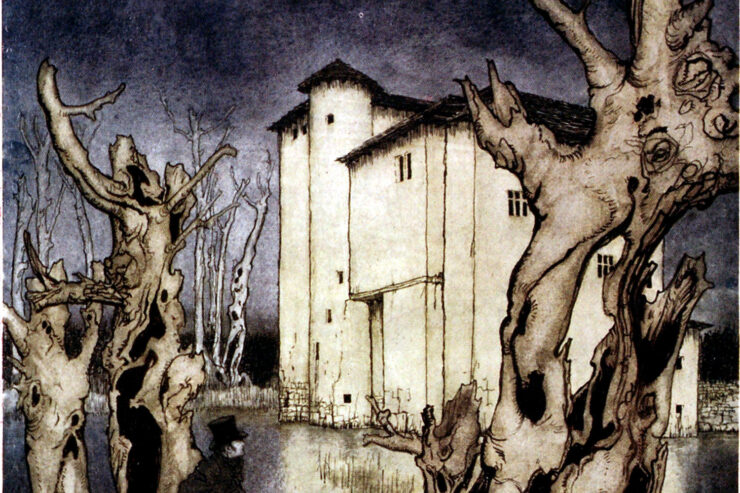
My favorite series right now is the “Ellie Jordan: Ghost Trapper” novels by JL Bryan. I’m not fond of the series name, but all the books are incredible, very well written, and run the gamut of the haunted horror tropes with everything from demons to dead serial killers to haunted kids camps. Ellie and her partner Stacey come in, mainly to people’s homes, do an investigation and historical research, then figure out how to protect the family from the nasty things. It’s dark and scary, but the good guys win. I love Ellie who has her own dark history and cheerful preppy Stacey. It’s one of the few series I preorder.
On the lighter but still scary side is Angie Fox’s “The Southern Ghost Hunter Mysteries.” Verity finds what she thinks is a vase and washes it out, but it is the urn of Prohibition gangster Frankie, and now his ghost is trapped on her land. He gives her the ability to see the ghosts who walk among us, and she’s soon on a mission to solve present day murders and give resolution to other ghosts. The hauntings and some of the ghosts are scary and dark, but Verity and her kindness to the living and the dead makes you feel very happy by the end of each book. Frankie’s very slow growth from being a total a-hole to being less of an a-hole through the series is a fun element. This is another preorder instant buy from me.
And on the TV front is SYFY’s SURREALESTATE where a group of realty agents act as ghostbusters who clean out the nasties so the homes will be safe to sell. Very scary. The second season is starting in the fall. I can’t wait.
The House Next Door (1978) by Anne Rivers Siddons is a perfect fit for this category — the hauntings take place in a newly constructed house, and are described from the neighbor’s POV instead of the people living in the home.
See also the short story “Where the Cluetts Are” by Jack Finney. A wealthy couple finds old blueprints for a Victorian house and has an exact replica built, and furnish it with authentic Victorian furniture. Soon, they find themselves having “memories” of life in those times (presumably, of the people who had lived in the long-vanished original house), and eventually stop leaving the house, having food delivered but otherwise not interacting with the “modern” world. And neighbors notice that sometimes the weather is “different” over the house, as if it’s simultaneously existing in the past as well.
I love Mexican Gothic and I’m interested in writing a haunted house novel of my own, so I should look into the others on this list.
K. J. Charles’ The Magpie Lord involves a haunted house but also a malevolent presence tied to dead ancestors and a sorcerers’ battle to exorcise them. Fun and very, at times explicitly, gay romance.
How to Sell a Haunted House by Grady Hendrix is pretty fun. Creepy dolls and puppets are good for a scare.
“The House of Ashes” by Stuart Neville.
Jordan L Hawk’s The Forgotten Dead has a haunted house with a complicated connection to the protagonist.
I’m in the middle of A Theory of Haunting by Sarah Monette (Katherine Addison). Not sure if there’s a fascinating twist yet or it’s just creepy af.
William Hope Hodgson’s The House on the Borderland is about a catastrophically haunted house.
My favorite haunted house story is Glen Cook’s “Dread Brass Shadows” where his P.I. Garrett, is asked to investigate the ongoings at the home of his former Sargent; to whom he owes his life. Death, hauntings, and complex conspiracies ensue.
Virginia Woolf’s short story “A Haunted House” is a delightful subversion of the traditional haunted house – two pages of precise and perfect prose.
What happens when a bumptious USian family in Oscar Wilde’s era rents a country manor-and-grounds that reportedly have been haunted for centuries? (Not a spoiler: this happens in the first couple of pages.) Wilde tells us in “The Canterville Ghost”; obviously a subversion (like @11), but wonderfully done. I read that there were multiple movies made under this name, none of them a patch on the book.
Jac Jemc’s masterful novel The Grip of It is my go-to for surrealist haunted-house horror. That book is insanely creepy.
Poppy Z Brite’s _Drawing Blood_ aka _Birdland_ is a Southern Gothic take on the haunted house, seen through an early 90s lens with cultural icons of the twentieth century.
Jacaranda by Cherie Priest is a truly scary haunted house novel, and is part of the same Steampunk world she began with the novel Boneshaker.
If I may humbly suggest my own The House of Drought (Stelliform Press), which transplants the classic haunted house story into the age of climate change and sets it across five time periods in an old colonial mansion in Sri Lanka, which is beleaguered by supernatural forces from both the inside and the outside…
Link: https://www.stelliform.press/index.php/product/the-house-of-drought-by-dennis-mombauer/
Does Slade House by David Mitchell count?
Gallant by V. E. Schwab is a terrific gothic tale. And the audiobook version with reader Julian Rhind-Tutt is divine.
Arkady Martine’s new novella “Rose/House” is a great haunted house story. (My spouse thinks it’s specifically an homage to The Haunting of Hill House.) It’s also a locked-room mystery.
Burnt Offerings by Robert Marasco, 1973. Creepy and wonderful haunted house tale.
Highly recommend Dweller on the Threshold by Skyla Dawn Cameron. The lockdown days of the early pandemic forces Nora to take refuge in a haunted house left to her by her estranged father. Some really great twists that I did not see coming.
I’d say that Slade House by David Mitchell very much counts, Sandy. In fact I came to the comments to mention it. It’s a brilliant book and has the form of a haunted house story.
The Agony House by Cherie Priest is another southern haunted house story that is pretty different and fun. Along the lines of others mentioned in this article and in the comments. Worth checking out.
House of Leaves by Mark Z. Danielewski seems to be in this category.
See also The Militia House by John Milas. Set in Afghanistan in 2010,a group of bored US soldiers at a forward base explore a long-abandoned former Soviet barracks outside the perimeter, which is rumored to be haunted. Their brief mid-day visit is so disturbing – the floor plan seems to shift, time elapses oddly, strange shapes, sounds and smells appear and disappear–that it seems to effect them afterwards in terrifying ways, and the first-person narrator becomes increasingly unreliable as he feels obsessed with going back.